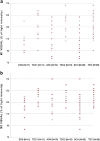Self-other recognition impairments in individuals with schizophrenia: a new experimental paradigm using a double mirror
- PMID: 30487540
- PMCID: PMC6261962
- DOI: 10.1038/s41537-018-0065-5
Self-other recognition impairments in individuals with schizophrenia: a new experimental paradigm using a double mirror
Abstract
Clinical observations suggest early self-consciousness disturbances in schizophrenia. A double mirror combining the images of two individuals sitting on each side of the mirror was used to study self-other differentiation in 12 individuals with early onset schizophrenia (EOS) and 15 individuals with adult onset schizophrenia (AOS) compared to 27 typically developing controls (TDC) matched on age and sex. The effects of intermodal sensory perception (visual-tactile and visual-kinesthetic) on self-other recognition were also studied. The results showed that EOS and AOS individuals, independently of age and schizophrenia severity, were centered on their own image compared to TDC, with both significant earlier self-recognition and delayed other-recognition during the visual recognition task. In addition, there was no significant effect of intermodal sensory stimulation on self-other recognition in EOS and AOS patients, whereas self-centered functioning was significantly increased by visual-tactile stimulation and decreased by visual-kinesthetic stimulation in TDC. The findings suggest that self-other recognition impairments might be a possible endophenotypic trait of schizophrenia.
Conflict of interest statement
The authors declare no competing interests.
Figures



References
-
- American Psychiatric Association. Diagnostic and Statistical Manual of Mental Disorders. 5th edn. Arlington, VA: American Psychiatric Publishing; 2013.
-
- Organization WH. ICD-10: The ICD-10 Classification of Mental and Behavioural Disorders: Clinical Descriptions and Diagnostic Guidelines. Geneva: World Health Organisation; 1992.
LinkOut - more resources
Full Text Sources
Medical

